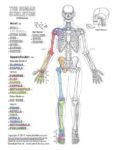The human body is a complex biological machine, composed of various systems that work together to sustain life. Here’s an overview of the main body systems:
1. Musculoskeletal System: Provides mechanical support, posture, and locomotion. It consists of bones, cartilages, and muscles.
2. Cardiovascular System: Transports oxygen, nutrients, and hormones throughout the body and eliminates cellular metabolic waste. It includes the heart, arteries, and veins.
3. Respiratory System: Facilitates the exchange of oxygen and carbon dioxide between the body and air, regulates acid-base balance, and enables phonation. It includes organs like the lungs and trachea.
4. Nervous System: Initiates and regulates vital body functions, sensation, and body movements. It is divided into the central nervous system (brain and spinal cord) and the peripheral nervous system (nerves outside the brain and spinal cord).
5. Digestive System: Mechanically and chemically degrades food for absorption into the body and use as energy. It includes the mouth, esophagus, stomach, and intestines.
6. Urinary System: Filters blood and eliminates unnecessary compounds and waste by producing and excreting urine. It includes the kidneys, ureters, bladder, and urethra.
7. Endocrine System: Produces hormones to regulate a wide variety of bodily functions, such as the menstrual cycle and sugar levels. It includes glands like the pituitary, thyroid, and adrenal glands.
8. Lymphatic System: Drains excess tissue fluid and defends the body against pathogens. It includes the lymph nodes, lymphatic vessels, and lymph.
9. Reproductive System: Produces reproductive cells and contributes to the reproduction process. It differs between males and females, with organs like the ovaries and uterus in females, and the testes and prostate in males.
10. Integumentary System: Provides physical protection of the body surface, sensory reception, and vitamin synthesis. It includes the skin and its appendages like hair, nails, sweat glands, and oil glands.
Each system has its unique functions, organs, and histology. Some organs may be part of more than one body system if they serve more than one function. These systems work in harmony to maintain the body’s overall health and functionality. Understanding these systems and how they interact is fundamental to understanding human biology..


